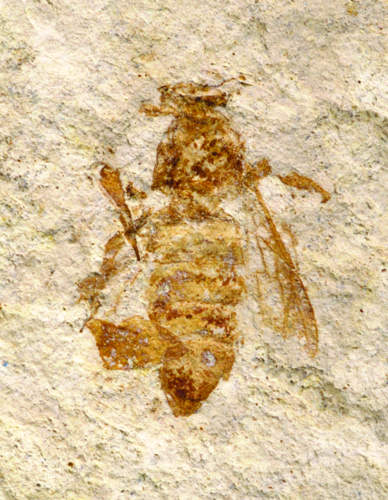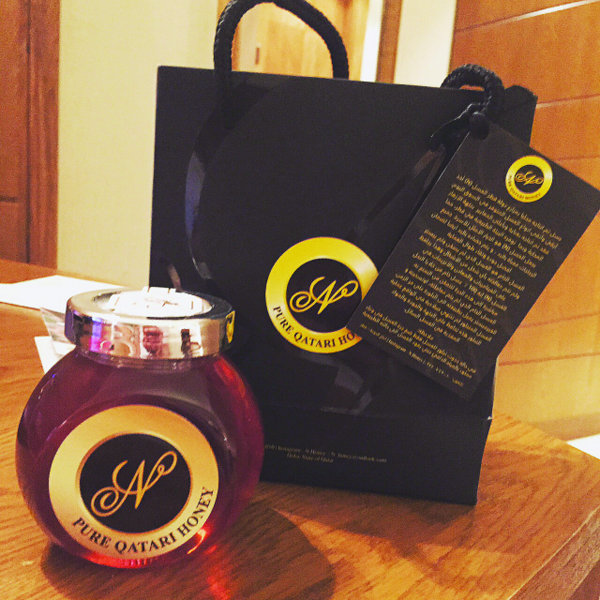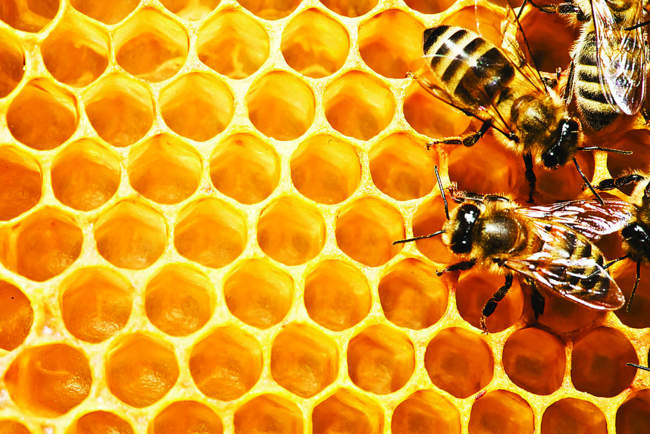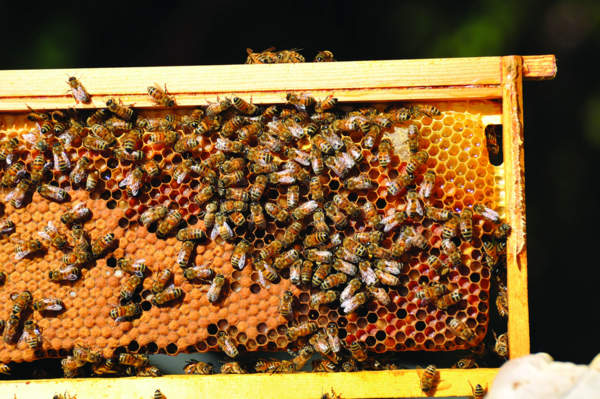Delightfully natural, translucently golden, honey is the incredibly labour‑intensive result of the work of tens of thousands of honey bees. Industrious colonies – of around 40,000–70,000 bees per hive – have a very fixed class structure and division of labour.
Depending on the environment and their access to nectar and pollen, honey bee foragers commonly fly up to 6.5 km in one sortie to collect nectar and pollen from flowers, and can potentially cover 20,000 hectares. It has been estimated that it can take bees 10 million foraging trips to make the equivalent of one 454 g jar of honey. And a bee, generally foraging for either nectar or pollen – but on occasions both – can carry up to a third of its weight in pollen, attached to its back legs; no mean feat!
There is no doubt that Qataris have benefited for decades from the honey they have harvested from natural honey bee nests and honeycombs, gradually moving on to apiaries (collections of artificially‑constructed beehives). However agriculturalists in the country now recognise the importance of establishing bee colonies on their farms. The bees raise the levels of pollination, ensuring bumper crops – but with the added economic benefits of honey and other bee-products.
Though you may not instinctively think of the Qatari desert as the nurturer of plants, flowers and nectar, the country now produces some 16 tonnes of honey per year (a big leap from the 10 tonnes in 2013), much of it from the flowers of the Sidra tree.
The claims made for New Zealand’s Manuka honey, and in the Arabian Gulf for Yemeni honey, are widely publicised. But Qatar’s apiarists (beekeepers) believe the local product is equally desirable.
 Love affair with honey through the ages
Love affair with honey through the ages
Apart from drizzling its delicate sweetness on food, honey’s healing properties have been recognised and utilised for thousands of years: to ease a sore throat, help healing of burnt skin, or in the cosmetics industry.
Ancient Egyptians made offerings of honey to their gods but also used it as an embalming fluid and a dressing for wounds. The earliest record of keeping bees in hives was found in the sun temple erected near Cairo in 2400 BCE. However cave paintings in Spain, dating from around 7000 BCE, show what are believed to be the earliest records of beekeeping. Fossils of honey bees and honeycomb have been dated to about 150 million years ago.
Bees have been making honey for the people of the Arabian Peninsula for well over 2,000 years. Eratosthenes, who lived from 276–196 BCE described the southern part of the Arabian peninsula as ‘[a] country [which] is in general fertile, and abounds in particular with places for making honey.’
Pliny the Elder, discussing Aelius Gallus and his unsuccessful military expedition to Arabia in 25 BCE, said that: ‘[among the] discoveries he reported on his return [were] … that the Sabei are the most wealthy, owing to the fertility of their forests in producing scents, their gold mines, their irrigated agricultural land and their production of honey and wax.’
Theodore and Mabel Bent, travelling through the Hadhramaut (South Yemen) at the end of the 19th century commented: ‘the honey. . .is most plentiful and tastes like orange flowers. . . It is packed for exportation in large round tin boxes, stopped up round the edges with mud. It is used in paying both taxes and tribute.’ Honey from southern Arabia was sent to Muslim populations as far away as Zanzibar, North India and Java, as well as being consumed locally.
 The medicinal benefits of honey
The medicinal benefits of honey
Honey is a humectant: it attracts and retains moisture, which makes it an obvious choice for the commercial manufacture (or home creation) of moisturising products, skin cleansers, creams, shampoos and conditioners.
It is antibacterial, and its high viscosity helps to provide a protective barrier preventing wound infection. Its immunomodulatory property is also relevant to wound repair.
In the laboratory honey has been shown to hamper the growth of pathogens such as E. coli and salmonella, and to fight bacteria, including Staphylococcus aureus and Pseudomonas aeruginosa. Whether it does the same in patients hasn’t yet been proven.
However, while honey is natural and considered harmless for adults, paediatricians strongly caution against feeding wild-gathered honey to children less than one year old because of the slight risk of botulism (spores of the botulism bacteria are found in dust and soil that could, theoretically, make their way into the honey).
Since 2012 Qatar’s Ministry of Environment has developed a programme to expand beekeeping in the country by providing free hives and bees, and organising training courses for would‑be beekeepers.
The Ministry has recently helped establish over 25 new apiaries in the north of Qatar, but despite previous healthy production figures this year’s output is likely to be reduced following severe dust storms in April that damaged many hives and colonies.
However in February 2015 some 80 local apiaries took part in a ‘Spring Honey Festival’ at the nation’s three main seasonal vegetable yards, in Umm Slal (Al Mazrouah), Al Khor and Al Wakra. Just more proof of the popularity of the product and the commitment of producers.
In its efforts to promote beekeeping, the Ministry, together with the Centre for Environment Friends, have utilised the extensive knowledge and experience of Qatari national Khalid
Al Suweidi in training a new generation of apiarists and increasing general knowledge of the importance of the honey bee.
Khalid was just 12 years old when he first harvested honey from a wild nest to give his father as a present; his fascination just grew.
Khalid established Bu Saif Apiaries (named after his son) in 2004; by 2012 he had some 150 hives in Qatar, producing 1–1.5 tonnes of honey per year, as well as an apiary in Abha in Saudi Arabia. He later developed apiaries in Oman. Bu Saif also operates a café in Doha’s Souq Waqif using and promoting Qatari honey products, and arranging tours of the apiaries in Al Shaihaniya. Bu Saif now produces four different honeys – Sidr, Spring, Lemon and Samar – harvested at separate times: in February, April, May and September.
Apart from the courses he has run, Khalid has also inspired Nawaf Al Obeidly to investigate the possibilities of turning a hobby into a business. ‘I became interested in honey about two years ago,’ says Nawaf. ‘My job takes me around the world and I found myself buying honey everywhere, but it wasn’t always good. Since our children love honey, I decided to try my hand at producing my own. I knew it would be 100% pure, natural, with no added sugar or artificial flavours; something I could feel comfortable giving them.’
Before embarking on the project, he spent months reading and researching the topic, discovering the importance of bees in the environment. ‘I started with just three apiaries, as a hobby: to get the best of the best for my family, and to teach my children about the environment and where our food comes from. Now I have over 30 apiaries, located mainly in Doha with a few in the north. We produce different kinds of honey, depending on the natural vegetation and environment. Having hives in Doha we benefit from the Sidr trees which line many main roads, but also from the gardens and parks.’ Sidr trees, the logo of Qatar Foundation, are culturally prized, and commonly grown.
The colour, taste and even thickness, of Qatari honey changes across the peninsula, depending on the farms, the available flowers – even the seasons. ‘The amount of honey produced also differs from place to place,’ says Nawaf. ‘Some hives produce 2–3 kg of honey, others 6–8 kg.’
The main challenge, say both Khalid Al Suweidi and Nawaf Al Obeidly, is the weather. ‘The harsh summer months can kill all the bees unless there is good shading, but even with proper housing and shading there is a huge chance of losing around 80-90% of the hive. Then during the winter months it gets too cold and adequate precautions must be made to keep the bees warm. Over the winter months the bees get weaker and need vitamins to keep them going. This makes them vulnerable to moth larvae and ants which take over the hives and kill all the bees if not maintained weekly.’
All Nawaf’s N Honey is hand harvested, taking the raw comb to the extractor, then to the strainer, then to the bottles guaranteeing an all natural product.
‘N Honey is raw honey – it hasn’t been heated, pasteurised or processed, so the important vitamins, minerals and enzymes are maintained. Honey that hasn’t been heated or had preservatives added to it has a natural tendency to crystallise. That crystallisation process does not take away any of its vitamins, minerals or enzymes, in fact it protects it, and a simple warming up of the honey makes it runny again.
‘We mainly package the honey in 250 g jars which is popular for gifts but also offer smaller packages of about 25 g for special occasion gifts. They can be customised for weddings, births, birthdays, company parties, festive months or anniversaries etc.’
But not limiting himself to Qatari honey, Nawaf says: ‘On some occasions we also have a limited supply of white mountain honey from other countries which is thicker and flowery; it can be scooped and spread on like butter. We also occasionally have full honey combs for sale; with about 1–2 kg of honey per frame.’
Neither Nawaf, nor his mentor Khalid, believe other countries have ‘better’ honey, than Qatar. ‘Ours is just as good if not better,’ says Nawaf. ‘It hasn’t been as widely known or marketed, but at the end of the day it’s all about how the honey is gathered and treated.’
 Seeking the necessary licences and Baladiyah approvals has taken Nawaf time. ‘But I’m expanding day by day. My Instagram account is getting more popular and N Honey’s reputation is growing fast. I gave away most of the honey for months but then I was advised to sell it, because it’s a great product and people can enjoy something natural and locally produced. I want to expand and produce enough to place N Honey in the market.
Seeking the necessary licences and Baladiyah approvals has taken Nawaf time. ‘But I’m expanding day by day. My Instagram account is getting more popular and N Honey’s reputation is growing fast. I gave away most of the honey for months but then I was advised to sell it, because it’s a great product and people can enjoy something natural and locally produced. I want to expand and produce enough to place N Honey in the market.
‘I would love to get a business partner, or to supply restaurants, bakeries, organic/natural juice stands, and move into honey for body care products. Maybe even to have a gift-arranging partner who could take part in fairs, events, and festivals. Right now I only plan to expand in the local market, although I have had offers to move the product into the GCC. If an opportunity crops up to be introduced to a farm I would happily look further into that.
‘Our pricing is competitive with other gourmet honeys, but it’s costlier than supermarket honey, because a lot of care has gone in the handling, quality and packaging of the product.’ And it isn’t ‘blended’ from sources in different countries!
Nawaf Al Obeidly and N Honey can be contacted via his Instagram account @n.honey, or by calling 7790 0010. You can enjoy sweet delights prepared with Bu Saif honey at their café in Souq Waqif, and also organise a tour of the Bu Saif apiaries in Al Shaihaniya. Find out more via the Instagram account @bosaifhoney
Few of us enjoying the golden foodstuff recognise the complexity of a bee colony or the difficulties in maintaining hives.
Basically there are four ‘castes’ of bees, plus a winter generalist state. Tens of thousands of worker bees, all females, assume responsibility for feeding, cleaning, nursing, and defending the group. Male drones live only to mate with the queen – the sole fertile female in the colony.
There are bees building the honeycombs; taking care of the babies; collecting water, propolis (resin used to seal unwanted open spaces in the hive), pollen and nectar; making honey; protecting the hive; and even cleaning the hive of carcasses.
Author: Gina Coleman and Sarah Palmer
Copyright © Marhaba Information Guide. Reproduction of material from Marhaba Information Guide’s book or website without written permission is strictly prohibited. Using Marhaba Information Guide’s material without authorisation constitutes as plagiarism as well as copyright infringement.









